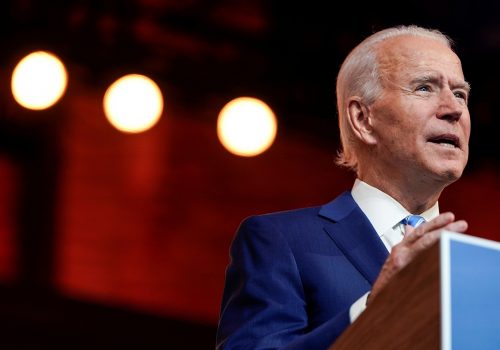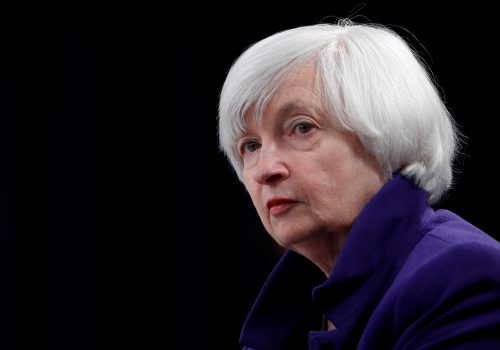FAST THINKING: The Fed caps its most important year ever
JUST IN
We’re kicking off this edition with a financial term: “quantitative easing,” or QE. It’s what the US Federal Reserve does when it buys up assets like Treasury bonds to inject funds into the economy, lowering borrowing costs and boosting consumer and government spending. This was more crucial than ever in 2020 as the Fed increased QE to unprecedented levels to keep financial fallout from the pandemic at bay. That, combined with the Fed’s move to lower its benchmark interest rate to zero, made this the most important year in the history of US monetary policy, according to Josh Lipsky, whose team at the GeoEconomics Center has been documenting the effects. The Fed announced today that these policies will largely continue next year and perhaps beyond—a decision that will define the early years of the Biden presidency. Let’s dive into what it all means.
TODAY’S EXPERT REACTION COURTESY OF
- Josh Lipsky: Director of the GeoEconomics Center
- Ole Moehr: Associate director of the GeoEconomics Center
- Nitya Biyani: Program assistant at the GeoEconomics Center
Why we should all be watching the Fed
- First, the basics: Ole notes that the Fed has two main responsibilities: maintaining price stability (preventing high inflation and deflation) and keeping employment as high as possible. Both of these became uniquely urgent this year: “COVID-19 caused an economic shock that pushed down price levels and dramatically increased unemployment numbers.” The Fed’s response? It opened its financial floodgates, committing to “open-ended, unlimited quantitative easing purchases that grew the bank’s balance sheet by more than $3 trillion to date” and extending record-low interest rates.
- Here’s what that means on a more granular level: “If you’ve recently taken out a loan to buy a house or car, you’re directly benefiting from the Fed’s expanded quantitative program that is lowering borrowing costs,” Ole explains. The program is “also a big reason stock markets quickly bounced back from the COVID-19 shock and helped 401(k) portfolios to recover their losses in the process.”
- But the benefits of this recovery have not been shared equally. Ole asks the crucial question: “How can monetary policy help Main Street catch up with Wall Street?” He points out that lending programs designed to help small businesses ultimately made up “less than five percent of the Fed’s overall response to this crisis, and some of the programs, including the ‘Main Street Lending Program,’ are set to expire by the end of 2020.”
What happened at the Fed’s year-end meeting today?
- For smaller businesses, there was no good news. “Today’s meeting did not change the outlook for these programs, so the ball is now in Congress’ court” to act and “avoid a significant increase in wealth and income inequality among Americans as a result of the pandemic,” Ole tells us.
- The good news is that Congress appears to be nearing an agreement today for a $900 billion relief package. Josh notes that the Fed can’t send people checks or increase unemployment insurance—“the types of stimulus that are the best at reducing inequality and protecting jobs. That’s what Congress can and should do.” He considers news of the brewing deal a positive development but notes that Joe Biden will want to do more while Republicans may consider this the end of the road.
- That means monetary policy will have to continue doing the heavy lifting, Josh says. “Fed Chair Jerome Powell made it clear today that aggressive quantitative easing and low interest rates will continue into 2021 and potentially longer.” Since interest rates are already so low, QE is the place where the Fed has the most room to run.
What that means for 2021
- Josh calls 2020 “the most important year in the history of monetary policy” not just in America but globally, as central banks around the world adopted measures similar to the Fed’s. Between quantitative easing and interest-rate cuts, he notes, nearly $8 trillion was injected into the global economy: “That amounts to 50 percent of the cumulative total of all quantitative easing on record before 2020.”
- For Nitya, whether the Fed is willing to continue these policies will dictate what the economy looks like in the early years of the Biden administration—and, by extension, what the global economy will look like. “What’s key here is how long this continues, because that is a good indicator of how long the recovery will take,” she says. “That impacts everything—mortgages, 401(k)s, jobs, general economic stability, and, of course, US power and standing in the world.”
- Here’s where Josh sees Biden’s economic team heading: The president-elect’s advisors, including his nominee for treasury secretary, Janet Yellen, a former Fed chair herself, want to “let the economy run hot,” which means not getting “spooked by a little increase in inflation” and instead focusing “on wage growth and jobs.” Today, Josh adds, “Jay Powell seemed to suggest—in his own way—that he agrees. That’s a positive sign for both the US and global economy.”
Check out Fast Thinking’s video series
Further reading
Tue, Dec 1, 2020
Global QE Tracker
EconoGraphics By
This Global QE Tracker allows users to compare the major central banks’ different quantitative easing policies, offers in-depth breakdowns of each institution’s specific QE measures, and explains in clear terms how QE and interest rates work together to produce successful monetary policy.
Mon, Nov 30, 2020
FAST THINKING: A speed read on Team Bidenomics
Fast Thinking By
Joe Biden has selected a slate of economic advisers that just might please his party while also (mostly) surviving confirmation in a potentially Republican-controlled Senate.
Mon, Nov 23, 2020
FAST THINKING: It’s Yellen for Treasury
Fast Thinking By
Janet Yellen could face an economy devastated by the coronavirus and the haphazard response to it in Washington. Josh Lipsky provides insight into how she might manage a difficult recovery.
Image: REUTERS/Brendan McDermid/File Photo


